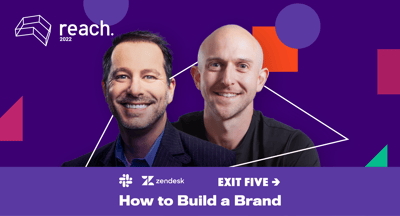December 13, 2022
.png?width=400&height=150&name=Copy%20of%20G2%20Image%20(1).png) by Shreya Mattoo / December 13, 2022
by Shreya Mattoo / December 13, 2022

Banking on demand generation to keep your business afloat?
Rising inflation and advertisement slowdowns have caused a stir in the B2B market. In its light, many businesses have laid off hundreds of employees and made deep cuts in their existing working capital.
While this sounds harsh, it happens because marketers focus too much on the promotional aspect of the product rather than investing in demand generation.
On December 1st at Reach 2022, we had the pleasure of hosting Carilu Dietrich, former Head of Corporate Marketing at Atlassian and former Senior Director of Global Advertising at Oracle, and Amanda Malko, former CMO at G2. The panel focused on how demand generation scales customer experience and drives efficient revenue growth.
Today, Carilu Dietrich is a CEO and CMO advisor of hypergrowth tech companies. She also co-founded Pledge 1%, a nonprofit encouraging entrepreneurs to focus on company growth and giving.
Malko initiated the session by asking Carilu to give us a walkthrough of her role as a marketer.
Dietrich started her career in enterprise sales in the early 2000s. She worked in inside sales and field sales for internet infrastructure companies. Her clientele included Yahoo, Intuit, and other prominent tech names. As Dietrich is from a sales background, she understands the do’s and don’ts of the sales industry very well.
Dietrich switched her career path from sales to marketing and started working for Plumtree as a public relations analyst. This began her prolific 20-year marketing career.
She went on a tour of duty for two years to learn about how each department within her company works. She worked across departments like PR, demand generation, field marketing, and mergers and acquisitions.
Her stints helped her grow as an experienced professional. She wrote ad copies for The Wall Street Journal and The Economist and led exciting marketing ventures at Oracle.
She also ran several brand awareness and demand generation campaigns. She was a part of a TV commercial on NBC for the America's Cup. She flew to LA to read movie scripts for Oracle’s Iron Man integration.
Dietrich was good friends with Jay Simons, Former Vice President, and Cameron Deatsch, CRO of Atlassian, who encouraged her to take on a new responsibility at Atlassian. While she headed the corporate marketing branch of Atlassian, the company went through a widely successful IPO.
Demand generation is a strategy that establishes omnichannel communication with your prospects through different brand channels like a landing page, emails, ads, and PR campaigns. It creates a buzz for your brand and brings you into the consumer spotlight.
You can use demand generation to promote your minimum viable products (MVPs), resources, webinars, and eBooks. People who find your content appealing can circle back to your website or register as a lead.
It gives a voice to your company mission in the online community, helps a person resonate with your product or service, and enhances your reputation.
As the software competition rose, Oracle faced several big blows. In 2008, Oracle had to cut 25% of its operating revenue by firing its social media marketing team. This decision increased the workload on existing employees expected to achieve the same goals as pre-layoffs.
Dietrich also lost a few family members, which made coping quite difficult. At the same time, the most experienced employee of her company quit. Times were rough, but she didn't give up.
Malko and Dietrich reflect upon the hard decisions they had to make throughout their careers. The decisions were mainly related to cost-cutting, hiring, and firing, which were not easy to take. They used to monitor the company's net revenue, budget, gross margins, and other financial details to make marketing investments.
When Oracle ran into loss, Dietrich kept her cool and worked closely with the CEO and CFO to determine the next move. It's essential to keep calm even while knowing the company is at stake; a hasty mind can never make sound financial decisions.
Thankfully, cooler heads prevailed, resulting in big bets for Oracle. The CEO praised her for her innovative spirit and leadership. This brings us to five things to remember while crafting a demand-gen strategy.
Dietrich believes tech startups need to acknowledge their services on a macroeconomic level. Money won’t come quickly at any stage of the next fiscal year. Her idea of splitting the difference between the work of sales and marketing departments receives equal affirmation from Malko. Here's what else they had to say.
You need to be efficient in strategizing your goals for next year. Spend only what you can afford, take big swings, and invest in the right subsidiaries or advertising channels. Third-party email integrations like Mailchimp and Unbounce can help in personalizing your outreach efforts.
Sometimes, you might have to sit on a bed of thorns and make tough decisions. Letting your employees go is one of them. However, if you see a pattern of underperformance, you’re the one who has to make the call.
Another key point is to never let go of your marketing philosophy. According to Dietrich, creating awareness about your product in a competitive market requires you to have a “secret recipe” for your product, something you have patented and thus cannot be reused.
Eliminate marketing channels that aren’t bringing in favorable engagement. If you feel you've been generating newsletters for quite some time without any positive impact, de-emphasize them. Don’t be afraid to try something new, like an audio podcast on your website. And always be on the lookout for free and creative alternatives for brand activation.
Take it to wired media if you want. Run commercials for 5 seconds or longer to fill the gap between two segments of an episode. Commercialized content stays at the top of the viewer's mind.
You can also use this time to reflect on your yearly targets. Analyze the performance metrics of your employees at regular intervals. Protect the cream of the crop; your top performers invest more time and effort in their job.
Dietrich describes demand generation as a dartboard. The inner circle consists of low-hanging fruit: people interested in your product. These folks sign up for your webinars and events, come to your gatherings, and share your content.
Malko agrees with the “low-hanging fruit” perspective. For G2, she gives that title to the software sellers registered for a “freemium subscription” to the product.
The people in the outer rings know about you as a business but might not necessarily want to collaborate. Keep them on your radar while running your next go-to-market (GTM) strategy. Let them know you, build connections, and introduce them to your product.
These prospects need hard facts and numbers to believe in your product's success. Bring market statistics into action. Define the struggles and pains consumers face today and how your product can solve them.
Dietrich also explains that if you make too many cuts in one go, you increase the burden on the remaining employees. They might become less productive due to more workload. Eventually, you won't be able to hit your goals for any business quarter.
As a leader, it’s your responsibility to share a fair amount of work for the sake of your team members. Having you as a moderator and a real-time contributor boosts their motivation. Otherwise, they might fall prey to procrastination or termination.
You might be firing an employee today, knowing you'll need them a year later when the economy is restored. But this practice results in burnt bridges. Plan it so that even your terminated employees have a “foot in the door.”
These ebbs and flows can be nerve-wracking, and it’s okay to feel so. When the money comes, you can bring in your lost resources again.
Malko agrees with Dietrich’s analogy of making the most out of important resources. She feels “less is more is the norm” of running a successful business. It allows you to adjust to reality, be creative, and resolve constraints.
Again pointing to the 2008 Oracle incident, she explained that Oracle has always been very cautious of its marketing stint. “For Oracle, everything mattered," Dietrich says. "A fantastic product, the product's virality, and word of mouth.”
That year, Oracle saw a drop in overall profit, and the annual revenue was modest. One way to retain revenue for a top company like Oracle was by cutting costs and improving efficiency.
Oracle had accounted for $1.3 billion in net income on revenue of $5.6 billion. The profit declined by $7 million, which is lower than the company had targeted. Many employees got smaller salary increases than anticipated. They were obliged to work harder just to get by.
Because of lower profits, Oracle had to terminate its social media marketing team. The organization depended on outbound sales calls and business development representatives (BDR) for lead generation and sales deals.
Cutting an important arm of the marketing team didn’t work out, and Oracle's organic traffic sunk 10 to 15%. The team also noticed that cutting SEM affected SEO, which was a significant bet for them. The team created correlations between current and lost variables to measure the impact of demand generation.
"A brand in hard times is brand-gen. We need to use demand-gen tactics to tell the world what our brand is and brand tactics to generate demand in the market."
- Carilu Dietrich
Former Head of Corporate Marketing, Atlassian
For the upcoming year, Dietrich feels that marketers should form connections at the grassroots. They should get their hands dirty, extract important consumer insights, and create contextual content. They should also attribute lead sources to understand where they are getting better leads in terms of quality and intent.
Another key point is knowing how to segment your leads according to the stage in their nurturing cycle. If you have diverse products, ensure a person interested in product A doesn't consume ads for product B.
Make a harmonious balance between every element of your campaign and benchmark all your consumer touchpoints. Ensure your website is built on a robust logical architecture with a sitemap, crawlable content, and on-page SEO.
Dietrich believes marketers will be looking to incorporate these strategies in 2023:
Dietrich thinks 2023 will see some big pivots in terms of demand generation.
Some companies might go from small and medium-sized businesses (SMB) to the enterprise market, while others may go for product-led growth (PLG), as it might be cost-efficient. A few might transition from being cloud-native to welcoming traditional companies.
As a B2B company, focus on having a testing mindset. Feed in inputs, calculate the hypothesis and then calculate the actual impact. Even small steps can result in large wins.
You might tweak your brand name a bit, only to find your inbox swamped with lead responses the next day. The key is finding the right content approach that gains relevant consumer traction.
Find your time and place to do these tests. Adapt to your product strengths, which will be key differentiators for you in the market. Trust in your employees' work, their experience will help you in all walks of your go-to-market strategy.
Another point is to understand the gaps and opportunity costs you derive from alternative plans and make the best decisions. Taking care of these elements makes up for a scalable demand generation framework.
An empathy-driven consumer mindset in a market where most brands are just minting money can be a brand differentiator. Take your time to build social networks and widen your professional circle. When you spread awareness in your network, the demand automatically increases.
You snooze, you lose! Learn how to nurture your lead in a contextual way to drive quality conversions.
Shreya Mattoo is a former Content Marketing Specialist at G2. She completed her Bachelor's in Computer Applications and is now pursuing Master's in Strategy and Leadership from Deakin University. She also holds an Advance Diploma in Business Analytics from NSDC. Her expertise lies in developing content around Augmented Reality, Virtual Reality, Artificial intelligence, Machine Learning, Peer Review Code, and Development Software. She wants to spread awareness for self-assist technologies in the tech community. When not working, she is either jamming out to rock music, reading crime fiction, or channeling her inner chef in the kitchen.
“The brand is a fire that drives customers.” - Bill Macaitis
.png) by Shreya Mattoo
by Shreya Mattoo
In 2019, there were only 21 products in the AI Writing Assistant market.
 by Sydney Sloan
by Sydney Sloan
When you play Monopoly, you follow the rules. When you play "house," there are no rules to...
 by Rebecca Reynoso
by Rebecca Reynoso
“The brand is a fire that drives customers.” - Bill Macaitis
.png) by Shreya Mattoo
by Shreya Mattoo
In 2019, there were only 21 products in the AI Writing Assistant market.
 by Sydney Sloan
by Sydney Sloan


